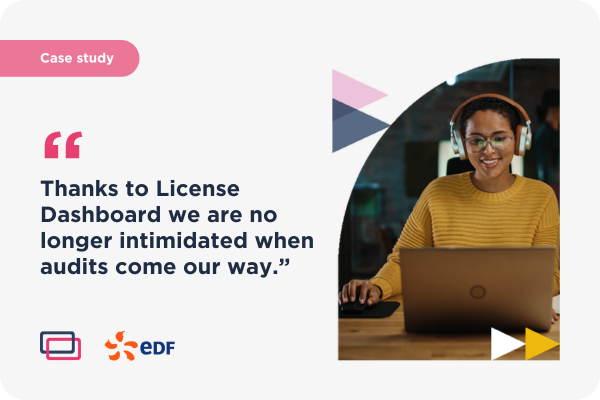When an organisation starts out on the path to establish a SAM function, many begin by putting a Licence Management tool in place or engaging with a partner such as License Dashboard to implement a Licence Management service. This is a positive first step on the path to gaining better visibility of any potential compliance risks. Not only this, but by successfully implementing such a tool or service an organisation will also be establishing a central store of data on a host of other IT related areas, such as IT hardware and purchases, which can be useful to a large number of different parts of an organisation.
License Management is just a small part of SAM
However, organisations often fail to realise that Licence Management is a reactive function, and forms only a small part of the wider SAM function. The aim of Licence Management is to deliver a compliance position; essentially a stock take for software. By collecting data on licence purchases it is possible, with enough data of sufficient quality, for a SAM professional to deliver a calculation of licence entitlement. Likewise, by collecting inventory data from any available inventory tools, again with some caveats around the quantity and quality of the data available, a SAM professional will be able to calculate a licence demand position. These two figures can then be reconciled against one another to deliver an effective licence position, highlighting areas of over- or under-licensing.
Even delivering a licence management service will require the SAM function to interact with a number of other functions within an organisation. The procurement team will need to provide data on licence purchases before any calculation of licence entitlement can be attempted. Likewise, any inventory tool data will need to come from the relevant inventory tool owner. In addition, any gaps or issues with the data will need to be addressed, but this will need to be completed by the function that owns the data – and often this will not be the SAM function.
Governance and process
This is where Governance and Process come into play. An organisation can be viewed as a collection of functions, working in concert to collectively achieve the ambitions of the whole. Wherever two different functions within an organisation are required to work together, it is necessary to establish why and how valuable time should be spent addressing any one particular task together:
- What the expectations of each function will be
- Which function will be responsible for what
- What the overarching aim of the interaction will be
To do this, an organisation will require governance and process. Governance to illustrate why two functions should co-operate with each other and to what end (and who will step in should it go awry), and process to illustrate how these two functions should work together to achieve their shared goal.
Even for the small subset of activities required to deliver a Licence Management service, governance and process will be needed to facilitate the delivery of an effective licence position. There will need to be governance and process in place to manage the provision of licence purchase data, how often this data is provided, and how any gaps in the data can be flagged with the data owners and closed moving forwards. The same governance and process will be required to manage the provision and improvement of data from the inventory tools. With all of this in place it should be possible to deliver a reactive Licence Management service, which will report on the effective licence position of an organisation at any given point in time.
Licence Management is reactive
License Management only reports on the state of an organisation’s IT as it stands at the time of the report. A SAM function is an evolution of this because it is proactive. While a Licence Management service can report on risks once they have materialised, the aim of a SAM function is to pro-actively identify potential risks before they ever materialise, and take steps to avoid them or constrain them to a manageable level. In order to be proactive a SAM function will need to integrate with an even larger number of the functions in an organisation, and each of these integrations will need to have governance and process in place to manage it.
Think about how many functions within your business might have an impact on the IT infrastructure. All of them probably.
- Requisition and procurement will act as the gatekeepers not only for new software licences, but also for new hardware, and will know way before new software enters an organisation what has been requested.
- Project managers will hold information vital to the SAM function about changes to the IT infrastructure within an organisation way before any changes manifest themselves in day to day business.
- Change management will have foresight of proposed changes which may impact the compliance position for an organisation long before anything actually changes.
- Apps packaging can affect the licence demand position for an entire organisation with a few keystokes.
In order to move from a reactive Licence Management function to a pro-active SAM function it is necessary to integrate the SAM function with all of the functions mentioned above, and where those functions interact governance and process will be required to facilitate the interplay.
As an example, let’s look at Apps packaging stated above. The apps packaging function plays a crucial role in the ability of an organisation to maintain compliance. Large organisations tend to package their applications to facilitate the rapid and seamless deployment of applications to end users. With a few keystrokes an application can be provided to a single user or an entire business. For this reason, when an application is packaged it is vital to ensure that not only the correct version and edition of the application, but also the correct application media is used. Pushing out the latest components of Microsoft Office to the organisation can cause all sorts of issues for compliance if the correct media has not been used.
Effective SAM means far more than Licence Management
Whereas previously organisations may have viewed the implementation of a SAM tool or a Licence Management service as a silver bullet to ‘fix’ their compliance issues, now more than ever organisations are beginning to realise that SAM is a far more complex and worthwhile proposition.
An effective SAM function has capabilities far broader than just Licence Management, and can provide a central hub for information that can prove useful to people across an organisation. After all, what organisation these days doesn’t rely on its IT to keep the wheels turning in one respect or another? But for SAM to truly fulfil its potential it needs to integrate with multiple functions across an organisation, and to make sure these interactions are fruitful and efficient governance and process is the key to unlocking the full potential of SAM.


























